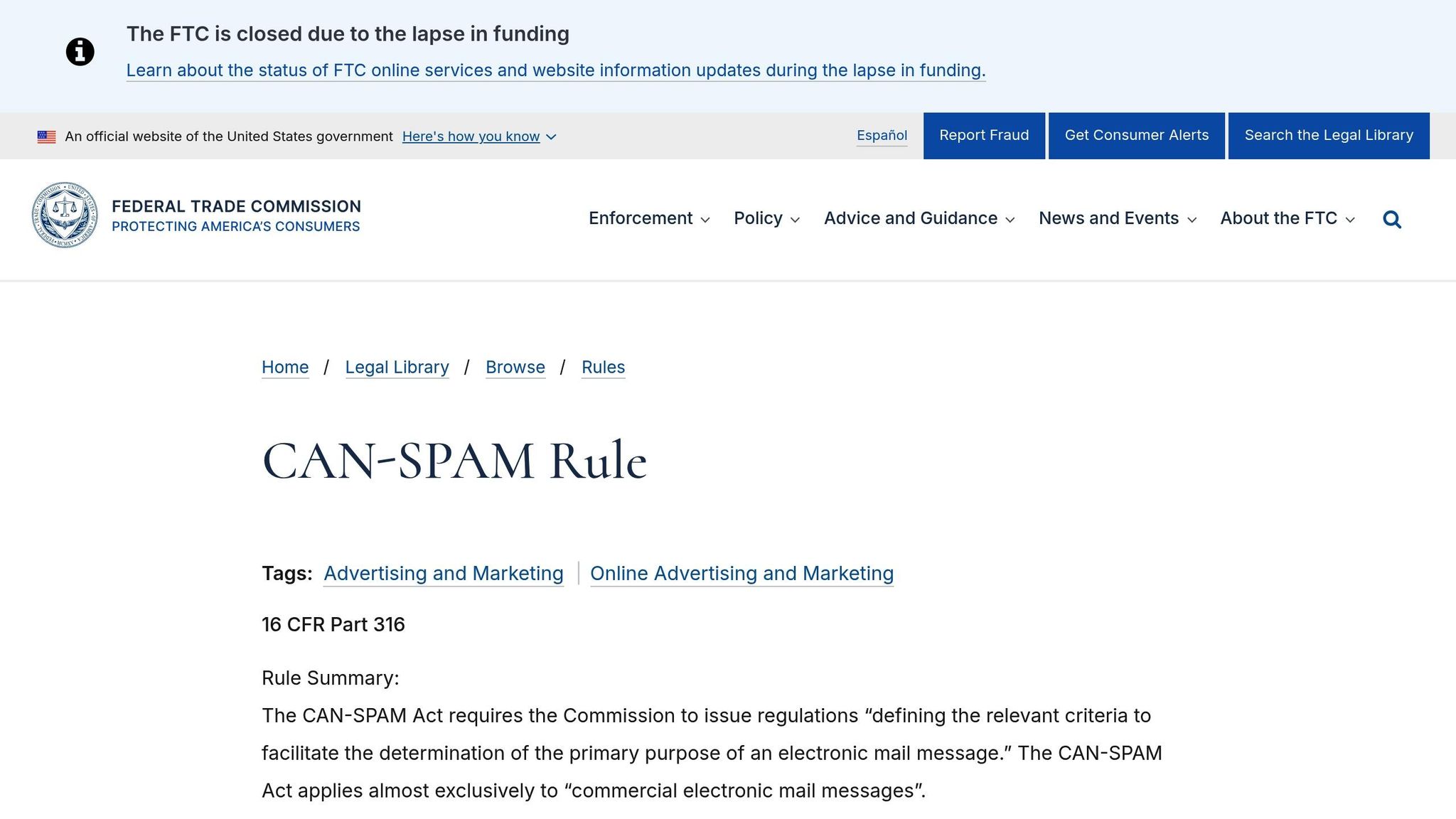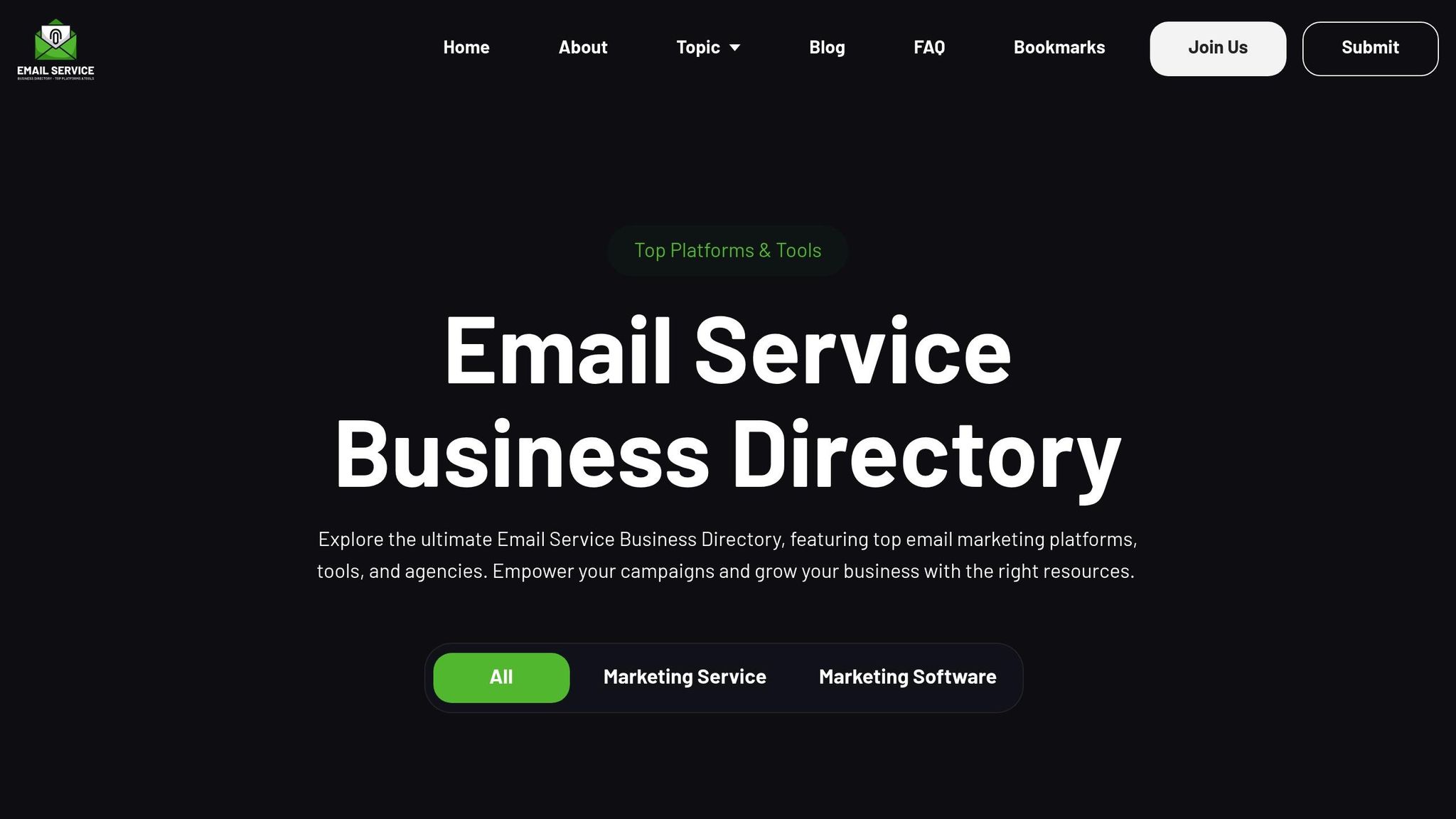Breaking the CAN-SPAM rules can cost you up to $51,744 per email. Misleading subject lines are one of the most common mistakes businesses make, and regulators are cracking down hard. Here's what you need to know to stay compliant:
- Your subject lines must match your email content. Don’t promise discounts or urgency that don’t exist.
- Sender information must be accurate. Ensure "From", "To", and "Reply-To" details are clear and truthful.
- Label promotional emails as advertisements. Use terms like "Advertisement" where required to avoid confusion.
- Avoid common mistakes like false urgency, bait-and-switch tactics, or exaggerated claims.
Staying compliant isn’t just about avoiding fines - it’s about building trust with your audience. Clear, honest subject lines lead to better engagement and fewer complaints. Use tools with built-in compliance checks to make the process easier and protect your business.
6 Legal Requirements You NEED to Comply With to Send Marketing Emails | CAN-SPAM Act Explained!

CAN-SPAM Subject Line Rules You Must Follow
The CAN-SPAM Act lays out specific rules that you need to follow when crafting subject lines for your emails. These aren’t just guidelines - they’re legally binding. Failing to comply can lead to hefty fines, so understanding these rules is essential.
Subject Lines Must Match Email Content
The most critical rule of CAN-SPAM compliance is straightforward: your subject line must accurately represent the content of your email.
For example, a compliant subject line like "Join Our Webinar on Marketing Trends" clearly describes the email's purpose - a webinar invitation about marketing trends. The subject line sets proper expectations, and the email delivers on that promise.
On the other hand, misleading subject lines, such as "Important Account Information" for a promotional email or "Last Chance to Save 50%" when no such offer exists, violate the law. These bait-and-switch tactics are exactly what regulators are on the lookout for when issuing fines.
The law is particularly strict about misleading claims. If your subject line promises a free trial, for instance, that trial must truly be free - no hidden fees or credit card requirements. Anything less could land you in hot water.
| Compliant Examples | Non-Compliant Examples | Why It Matters |
|---|---|---|
| "Join Our Webinar on Marketing Trends" | "Important Account Information" (for promotions) | Accurately reflects the email's content and purpose. |
| "20% Off Select Items This Weekend" | "20% Off Everything" (when exclusions apply) | Clearly communicates limitations to avoid misleading recipients. |
| "Monthly Newsletter: Industry Updates" | "Urgent: Action Required" (for a newsletter) | Sets realistic expectations without creating unnecessary urgency. |
Make sure your subject lines are clear, honest, and directly tied to the email’s content.
Sender Information Must Be Accurate
Your email’s sender details - like the "From", "To", "Reply-To", and routing information - must be truthful and transparent. Misleading or false header information is strictly prohibited. Recipients should immediately know who sent the email and how to contact you if needed.
This information is not just about compliance; it’s about trust. When your sender details are clear and accurate, it reassures recipients that your email is legitimate and builds a sense of credibility.
In addition to accurate sender information, another key compliance factor is proper labeling for promotional emails.
When to Label Emails as Advertisements
If your email’s primary purpose is to promote or advertise a product or service, it must be clearly labeled as an advertisement. This ensures recipients can easily identify marketing content.
You can meet this requirement by including terms like "Advertisement" or "ADV" in the subject line or body of the email. The labeling must be obvious and not buried in fine print.
However, this rule doesn’t apply to all emails. Transactional emails - such as order confirmations, shipping updates, or account notifications - don’t need to be labeled as advertisements, as their primary purpose isn’t promotional. It’s important to distinguish between these email types because failing to label commercial emails correctly can lead to serious penalties.
Regulators take these rules seriously, and non-compliance can result in substantial fines. Following these guidelines not only helps you avoid legal trouble but also ensures you maintain trust with your audience.
Common Subject Line Mistakes and Their Consequences
Understanding subject line mistakes is crucial to avoid hefty fines and protect your reputation. Violating CAN-SPAM rules, even unintentionally, can lead to financial penalties and long-term damage to your brand. Let’s explore common missteps and their repercussions, building on the basics of compliance.
Subject Lines That Break the Rules
Misleading subject lines - whether through false urgency, bait-and-switch tactics, or exaggerated claims - are among the most frequent violations of CAN-SPAM regulations. These errors not only risk fines of up to $51,744 per violation but can also erode customer trust and tarnish your reputation.
False urgency involves creating a sense of time pressure when none exists. For example, subject lines like "Last Chance to Save 50%!" or "Only 3 Left in Stock!" are deceptive if there's no real deadline or scarcity. These tactics mislead recipients and violate CAN-SPAM rules.
Bait-and-switch tactics promise one thing but deliver another. A subject line like "Important Account Information" that leads to a promotional email about a product launch tricks recipients, who expect account-related updates, not marketing content.
Overstated promotional claims exaggerate offers or misrepresent their terms. For instance, "You've Won a Free Gift!" when conditions apply, or "Exclusive Offer" for deals that are widely available, mislead recipients and breach compliance requirements.
Companies That Got Fined for Subject Line Violations
Real-world penalties demonstrate how seriously regulators enforce these rules. One company faced a $900,000 fine for disguising promotional emails as personal messages. This case underscores the importance of transparency. Subject lines must clearly and honestly reflect the email's content - attempting to mask commercial intent as personal communication is both risky and costly.
Good vs Bad Subject Line Examples
Looking at examples of compliant and non-compliant subject lines can clarify what works and what doesn’t. The table below highlights specific cases and explains why each one either meets or fails to meet CAN-SPAM requirements.
| Subject Line Example | Compliant? | Why/Why Not |
|---|---|---|
| "Get 20% Off Your Next Order" | Yes | Accurate if the offer is genuine and detailed in the email |
| "Your Invoice is Ready" | No | Misleading if the email is promotional, not transactional |
| "Monthly Newsletter: October 2025" | Yes | Reflects the email content accurately |
| "Act Now – Limited Time Only!" | No | Creates false urgency if no real deadline exists |
| "Exclusive Offer for Our Valued Customers" | No | Misleading if not all recipients are actual customers |
Compliant subject lines succeed because they truthfully represent the email’s purpose without exaggeration or deception. For example, "Get 20% Off Your Next Order" is clear and accurate if the offer is real. In contrast, non-compliant lines like "Your Invoice is Ready" mislead recipients by suggesting a transactional message when it’s actually promotional. Similarly, "Act Now – Limited Time Only!" implies urgency where none exists.
Beyond legal compliance, honest subject lines enhance email performance. When recipients trust your subject lines, they’re more likely to open future emails and engage with your content. On the other hand, deceptive practices might boost short-term open rates but harm long-term relationships, leading to higher unsubscribe rates and potential spam complaints.
Violating these rules can result in lawsuits, reputational harm, and loss of customer trust. Misled recipients are less likely to engage with your brand and may flag your messages as spam, damaging your email deliverability and sender reputation. Transparency isn’t just a legal requirement - it’s a cornerstone of building lasting relationships with your audience.
sbb-itb-6e7333f
How to Write CAN-SPAM Compliant Subject Lines
Now that we've covered common mistakes with subject lines, let’s dive into creating ones that are both effective and compliant with CAN-SPAM regulations. Following these guidelines doesn’t mean sacrificing engagement - it’s about being clear, transparent, and building trust with your audience.
Write Honest Subject Lines That Match Your Content
Your subject line should accurately reflect the content of your email. Avoid exaggerations, false promises, or any misleading claims, as these can lead to fines of up to $51,744 per email.
For example, if you’re promoting a 20% discount, a clear subject line like “Save 20% on Your Next Purchase” is far better than something vague like “Massive Savings Inside!”. Specific details set the right expectations and build credibility.
It’s also important not to imply prior interactions that didn’t happen. A subject line like “Re: Our Last Conversation” is misleading if there was no previous communication. Similarly, avoid phrases like “Urgent: Account Suspended” for promotional emails, as this misrepresents the email’s purpose and can erode trust.
A great example of compliance is the Rosolowski v. Guthy-Renker LLC case in 2014. The court ruled that a subject line mentioning a "free gift" wasn’t misleading because the email clearly explained that the gift required a purchase. This shows the importance of aligning your subject line with your email’s actual content.
Keep your commercial intent clear. Instead of a generic subject line like “Important Information About Your Account” for a sales email, try something direct like “Special Offer on Premium Services”. Transparency goes a long way in gaining your audience’s trust.
Make Subject Lines Personal and Relevant
Personalization can improve engagement, but it has to be genuine and aligned with the email’s content. Use accurate recipient data to craft subject lines that feel tailored. For instance, if a customer subscribes to your updates, a subject line like “John, Your Weekly Marketing Update” adds a personal touch.
When referencing past interactions, make sure they’re real. For example, after a customer purchases a service, you could use a subject line like “Follow-up Resources for Your Recent Consulting Purchase”. Avoid phrases like “As we discussed” unless there’s been an actual prior conversation.
You can also make subject lines more relevant by aligning them with industry-specific interests. For example, “New Compliance Tools for Financial Services Teams” works well if your email content supports that claim. This approach not only boosts relevance but also ensures your messaging stays truthful.
Check Your Emails Regularly for Compliance Issues
Writing compliant subject lines is just one part of the equation. Regularly auditing your email campaigns helps catch potential compliance issues early. Use a checklist to review subject line accuracy, sender details, and unsubscribe options. Training your team on CAN-SPAM requirements and documenting your review process ensures everyone stays on the same page.
Pay attention to recipient feedback. High unsubscribe rates or spam complaints can indicate that your subject lines might be misleading. Before sending an email to your full list, test your subject lines with a smaller audience to identify and fix any issues.
Many email marketing platforms offer automated tools to flag problematic subject lines, making compliance reviews quicker and easier. Staying informed about legal updates and enforcement trends is also crucial. As CAN-SPAM enforcement evolves, there’s growing scrutiny on misleading claims and implied relationships. Regular reviews ensure your campaigns stay compliant.
For additional support, the Email Service Business Directory provides resources to help businesses find email marketing platforms with built-in compliance features. These tools can simplify adherence to CAN-SPAM rules while helping you optimize campaign performance.
Finding Compliant Email Tools with Email Service Business Directory

Staying compliant with email marketing laws starts with choosing the right tools. The right platform not only ensures adherence to regulations but also helps you avoid costly fines.
The Email Service Business Directory provides a carefully curated list of email marketing platforms equipped with essential compliance features. These include subject line validation, automated opt-out management, and sender authentication protocols like SPF, DKIM, and DMARC. Such safeguards play a key role in reducing legal risks and promoting transparency in your email campaigns.
Here are some must-have compliance features to look for:
- Tools that detect and flag misleading subject lines before sending
- Real-time compliance alerts to address potential issues immediately
- Automated opt-out management to process unsubscribe requests within 10 business days
The directory’s comparison tool makes it easy to evaluate platforms based on features like audit trails, compliance templates, and responsive customer support.
Choose Platforms That Help You Stay Compliant
Industry data shows that businesses using platforms with automated compliance checks and subject line validation report up to 70% fewer violations. This not only reduces legal risks but also improves the overall performance of email campaigns.
Better Campaign Performance with Compliant Tools
Compliance isn’t just about avoiding fines - it also enhances your email marketing results. Tools with built-in compliance features improve deliverability rates, strengthen your sender reputation, and lower complaint rates. Simply put, compliant emails are more likely to land in inboxes and engage recipients.
Consider this example: A retail company using a platform listed in the directory avoided fines of up to $53,088 per violation by catching misleading subject lines before sending. Another business benefited from automated opt-out management, ensuring timely processing of unsubscribe requests and maintaining a more engaged email list - all while reducing legal exposure.
The Email Service Business Directory stays up-to-date with changes in CAN-SPAM regulations and industry standards. It also offers expert articles and compliance guides to keep you informed about best practices.
Take the First Step Toward Compliance
Selecting a compliant email marketing platform is a critical step in protecting your business. Use the directory to narrow down platforms with strong compliance tools, such as subject line validation, opt-out management, and sender authentication. Once you’ve chosen a provider, train your team on compliance best practices and set up automated checks to ensure you consistently meet CAN-SPAM requirements.
Keep in mind that your business is still responsible for compliance, even when working with third-party vendors. By listing only platforms with proven compliance records and robust legal support features, the directory helps you minimize risks, save time, and make informed decisions.
Stay Compliant and Protect Your Business
Staying compliant with CAN-SPAM regulations isn’t just about avoiding penalties - it’s about protecting your business and earning customer trust. With fines reaching up to $53,088 per violation as of March 2025, even one misleading subject line could cost your business thousands of dollars.
History shows that non-compliance can quickly spiral into serious problems. To stay on the safe side, your subject lines must accurately represent the email content, steer clear of deceptive wording, and clearly indicate when a message is an advertisement.
But compliance isn’t just about avoiding fines. Transparent and honest subject lines help you build stronger relationships with your audience. When customers trust that your emails deliver what the subject line promises, they’re more likely to open future messages and engage with your content. This trust directly improves your sender reputation and email deliverability.
Choosing the right email marketing platform also plays a big role. Tools found in the Email Service Business Directory can help you stay compliant by offering built-in safeguards. These platforms can flag potential violations before your emails go out, handle opt-out requests automatically within the required 10-business-day window, and ensure your emails meet authentication standards set by major providers.
Regularly auditing your email practices is another critical step. Double-check your subject lines, confirm that your sender information is accurate, and test your unsubscribe links to ensure they work properly. Keep in mind that these opt-out links must remain active for at least 30 days after sending. Even if you’re working with third-party email providers, your business is still responsible for compliance. To minimize risks, partner with platforms that have strong compliance track records and legal support features. This allows you to focus on growing your business while staying protected.
FAQs
What are some examples of misleading subject lines that could result in CAN-SPAM violations?
Misleading subject lines are a frequent violation of the CAN-SPAM Act and can result in hefty fines. Here are a few examples to watch out for:
- False promises: Subject lines like "Claim your free gift now!" when, in reality, there’s no free gift to be claimed.
- Deceptive urgency: Phrases such as "Your account will be closed today!" when no immediate action is required.
- Bait-and-switch tactics: Using a subject like "You’ve won a prize!" to grab attention, only to promote a product or service instead.
To stay on the right side of the law, make sure your subject lines clearly and honestly represent the email's content. Avoid any wording that could confuse or mislead your audience.
How can businesses use email marketing platforms to stay CAN-SPAM compliant?
To comply with CAN-SPAM regulations, businesses should opt for email marketing platforms equipped with tools to manage compliance efficiently. These platforms help ensure subject lines are honest, provide clear opt-out options, and display accurate sender details.
A dependable platform can make staying compliant easier by automating essential tasks, such as processing unsubscribe requests and keeping email lists up to date. Companies can evaluate different email marketing solutions to find one that suits their requirements while supporting adherence to CAN-SPAM guidelines.
Why is it necessary to label promotional emails as advertisements under the CAN-SPAM Act?
Labeling promotional emails as advertisements is a crucial part of staying compliant with the CAN-SPAM Act. This law is designed to promote transparency and protect consumers from misleading practices by requiring businesses to clearly indicate when an email is promotional. This helps recipients easily identify advertisements and separate them from other types of messages.
Ignoring this requirement can lead to serious consequences, including fines of up to $50,120 per violation. Beyond avoiding penalties, properly labeling promotional emails shows your audience that your business values honesty and clear communication, which can go a long way in building trust.


